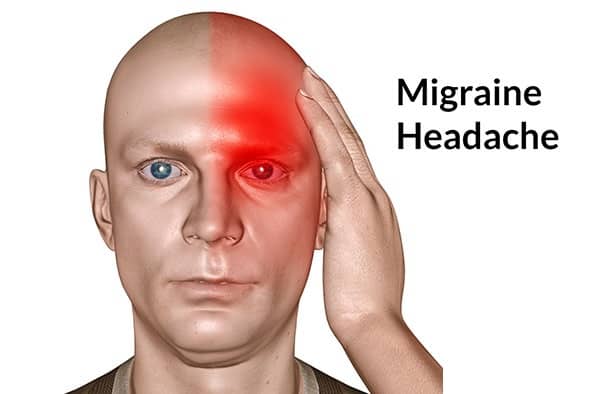A migraine is a headache that can cause severe throbbing pain or a pulsing sensation, usually on one side of the head. It's often accompanied by nausea, vomiting, and extreme sensitivity to light and sound.
Migraines can strike at any time. They affect about 15% of Americans, and women are three times more likely to get them than men. Elizabeth Ekpo and Marc Lenaerts, headache medicine specialists in UC Davis Health’s Department of Neurology, explain migraines and how you can better manage them.
What is migraine?

Migraine is a condition or syndrome, not just a headache. Headache is a key symptom but not always present during a migraine. The headache pain is caused by nerve-controlled inflammation of the dura, or the membrane between the brain and the skull.
Someone with fewer than 15 headache days per month has episodic migraine. Those who have 15 or more headache days per month have chronic migraine.
What causes migraines?

Migraines are likely caused by a nerve that inflames the dura, spreading pain and changing local blood flow. There may also be genetic causes of migraine. There are multiple triggers that may lead to a migraine attack. Common examples include a drop in estrogen levels (pre-menstruation), alcohol use, stress, cold weather fronts, and sleep deprivation.
What are the treatments for migraines?
These medications can help block pain signals and inflammation in the body:
1: acetaminophen
2: opiates
3: non-steroid anti-inflammatory drugs (NSAIDs) such as Ibuprofen or Naproxen
4: triptans (Sumatriptan)
However, overuse of these medications can lead to medication overuse headaches (formerly known as rebound headaches.
Botulinum toxin (Botox) is one medication approved by the U.S. Food and Drug Administration (FDA) that can help treat chronic migraine. Four other options to help prevent migraines are also available in injectable forms. They include Aimovig, Ajovy, Emgality, and Vyepti. Most patients taking these medications have an average of 50% fewer migraines per month.
Where is migraine pain typically located?

Your medical provider can give guidance on what is best for your situation. This information does not constitute medical advice or diagnosis.
Migraine pain is often one-sided, but can occur anywhere on the head, neck, face, or all over. The pain can feel like a throbbing or pulsing sensation. It can start in the forehead, around the eyes, or on the side of the head. The pain can gradually worsen and may spread across the head.
What can help prevent migraines?
A healthy lifestyle can help prevent migraines. This includes sticking to an all-natural diet, regular exercise, and keeping a healthy weight. Regular sleep is paramount. Stress relief techniques such as yoga, pilates, and meditation can also help prevent migraines.
What are migraine symptoms?
Migraine symptoms can include:
Cravings or loss of appetite
Nausea
Vomiting
Diarrhea
Lightheadedness
Tiredness
Swelling
Head congestion
Trouble speaking
Confusion
Sensitivity to lights, noises, smells, movements, and temperature
Some migraine sufferers see bright shimmers, zig-zag lines, or other geometric shapes. Others may experience blank or blurred vision or see their surroundings in one color such as yellow or pink. In more complex cases, visual hallucinations can occur.
How is migraine syndrome diagnosed?
The rules for headaches is somewhere around five cerebral pain assaults over your lifetime with the run of the mill side effects, and no fundamental reason. There is likewise a classification of headache assaults without head torment. There's no natural marker or explicit test for headache (like a hereditary test or imaging instrument). Eventually, conclusion depends on your consideration supplier.
What separates migraines from other kinds of headaches?
Since headaches can include torment in the cheeks or regions close the sinuses, they can frequently be mistaken for sinus cerebral pains. Sinus cerebral pain is certainly not an authority finding yet a side effect of intense sinus disease.
A purported "strain migraine" is portrayed by broad head torment with gentle, pressure-type torment without different side effects.
Group cerebral pains are uncommon and fundamentally influence men. They're described by assaults of repulsive agony as a rule around one eye. Side effects incorporate perspiring, sorrowful eyes, hung eyelid, clogged and additionally trickling nose. The assaults happen in groups at specific times (spring and fall, early morning, and so on.).
Does every migraine have a trigger?
Most headaches don't have triggers, or we misrepresent triggers. For instance, before a headache, a patient might need chocolate and gets a migraine in the wake of eating it. The headache isn't in fact "set off" by the chocolate. All things considered, the patient's desire for chocolate can be a pre-side effect of the headache.
Are some people more at risk for migraines?
Ladies are multiple times bound to have headaches than men and are bound to foster constant headaches. Headaches are more normal in the Western Side of the equator, logical for hereditary reasons.
Chemicals assume a part in headaches. For instance, a lady's period and the beginning of menopause can increment headache risk. Patients who have headaches (particularly a specific sort called headache with quality) can be in danger for strokes.
Headache is a long lasting condition, yet side effects happen generally between high school years and about age 60. A few patients' headache days will blur as they age. Be that as it may, some will keep on encountering headaches a ways into their 80s.







